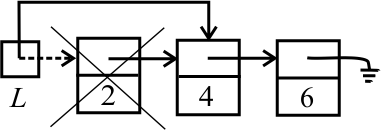33C. Example: Remove a Value from a Linked List
Suppose that remove(x, L) is intended
to be a destructive
function that removes the first occurrence
of x from list L, or does nothing if x
does not occur in L. For example, if
L is [2, 4, 2, 4, 5] and you perform
remove(4, L), then L is changed to
[2, 2, 4, 5]. The cases are as follows.
If L is empty, do nothing, since
x obviously does not occur in L.
-
If L is nonempty and the head of L
is equal to x, then set L to its tail.
However, the cell that contains x is
presumably no longer needed.
So it should be deleted. Look at how it needs
to work when L is [2, 4, 6] and x is 2.
If L is not empty and its head is not equal
to x, then remove x from the
tail of L.
Expressing that in C++ yields the following definition
of remove. In the second case, we need to be careful
manipulating pointers to avoid cutting the branch out from
under ourselves.
void remove(const int x, List& L)
{
if(L != NULL))
{
if(L->head == x)
{
List p = L;
L = L->tail;
delete p;
}
else
{
remove(x, L->tail))
}
}
}
